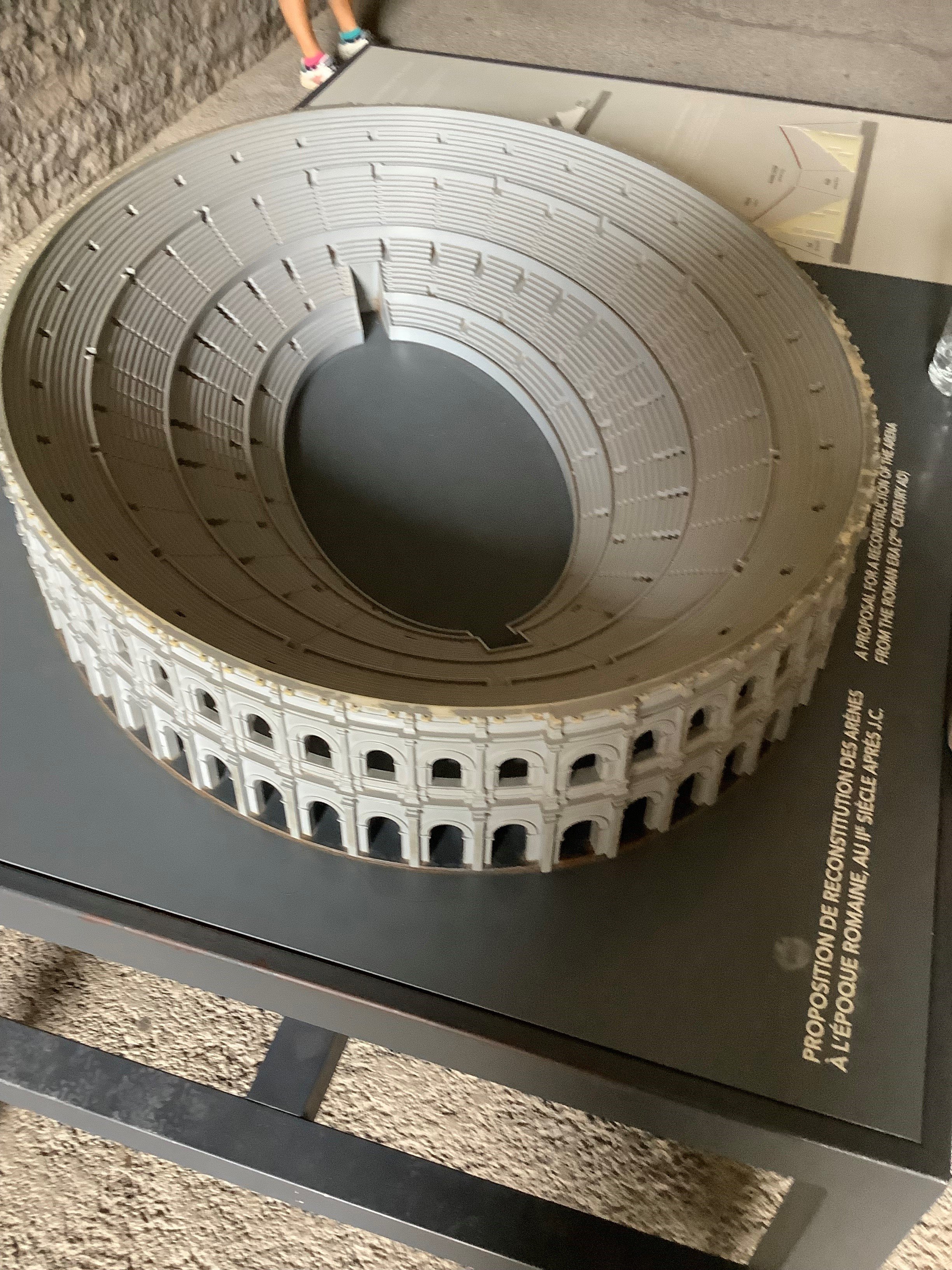XIX Nîmes France (Nemausus)
What3words – enhanced.inquest.torches
Visited August 2023
Status – One of the very best
Construction date - 1st Century AD
Capacity - 24,000
In the line of southern towns along the Via Domitia - the ancient Roman main highway from Italy to Spain, lies Nîmes. The place that launched a trillion pairs of work trousers, through the invention of a woven cloth dyed with indigo (de nîmes/denim) is packed with historic and architectural treasures. The greatest is the amphitheatre which is a stunning and unmissable gem.
One of the best-preserved Roman amphitheatres in the world. 133 metres long and 101 metres wide , with an arena 68 metres by 38 metres. The outer facade is 21 metres high with two stories of 60 arcades. It is among the 20 largest Roman amphitheatres of the 247 of which physical evidence is known. It could hold 24,000 spectators on 34 tiers of terraces and was modelled on a combination of the earlier structure at nearby Arles and the Flavian Colosseum of Rome. Its construction is totally hollow with circulatory corridors and a network of stairs and vomitoria that will be familiar to anyone who has been in a modern sports stadium.
The website The Roman amphitheatre - Office de Tourisme et des Congrès de Nîmes (nimes-tourisme.com) can show and give you a wealth of information about the history and survival of this incredible structure. Click on the link to the Amphitheatre and then the one to ‘see the webdocumentaire’ . If you skip the bits with actors and cartoons and follow the links to history and restoration there are photographs, prints, short history lectures and CGI virtual tours.
The story of Nîmes encompasses the collapse and shrinkage of the Roman Empire, depopulation of towns, and the lawlessness and infighting that occupied subsequent centuries. If you had a massive amphitheatre in your vulnerable town you could do a lot with it, two options being to use the parts to build a wall around your settlement, or make the outer walls of the amphitheatre safe and turn it into a castle/redoubt.
Gladiatorial contests were banned by the Emperor in 404AD. By the 6th Century the Visigoths had walled up the external arches and turned the Nîmes Amphitheatre into a fortress. In the 8th Century the ‘Carolingian Counts’ moved in and added their own extensions to form a fortress/palace. This was taken over by the ‘Counts of Toulouse’ in the 9th century who occupied it until the 12th century when it became a royal chateau until Viscount and Knights made their exit in the 14th century. At this point the locals started moving in. 58 of the 60 external arches were incorporated into house conversions. A similar number of residential buildings occupied the interior together with two churches and ecclesiastical residences. More were built onto the external walls. By the 18th century, some 1500 people lived in and around the structure.
A decree of the Council of State made in 1786 recognised the Arena as one of the most beautiful surviving Roman monuments. A lot happened in France at the end of the 18th Century, in particular a revolution and formation of a Republic. By 1807 a prefectoral decree stated that the ancient magnificence was dishonoured by the ‘vile constructions erected there during the barbarian centuries..’, and that by renovating it the city would halt the spread of disease through the insalubrious hovels obstructing parts of it and remove the insult to this venerable monument.
Post revolutionary France acquired a new enthusiasm for its architectural heritage, that desire to equate a new empire with a great ancient one, as well as slum clearance. The ‘new’ France set about revealing, preserving and restoring many sites. The houses and buildings within, and attached to, the arena, were demolished and the occupants relocated, the structure was excavated and repaired and restoration and repair continues to this day. From the mid 19th Century it hosted bullfights, circus and acrobatic shows, operas, military parades and it continues to accommodate Jazz festivals, Roman re-enactments and rock concerts.
It’s Only Rock & Roll
Bullfights, circus shows and opera in the re-booted amphitheatre were inevitably followed by jazz festivals and rock concerts. If you want the full and very long list, take a look at the Festival of Nimes website. 2024 will include Eric Clapton, Simple Minds, Dua Lipa, Avril Lavigne and James Blunt. Past notables are Radiohead, Nine Inch Nails, Metallica, Depeche Mode, Sam Smith, Rammstein, The Pretenders, Slipknot and…. you’ve guessed it, Sting.
Promised You a Miracle - 2018











